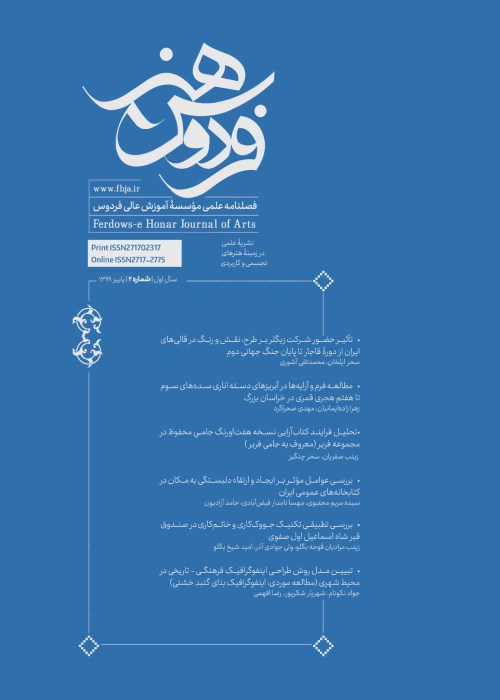Comparative study on physical characteristics of Urban walls (Cases studies: Bala and Paein Khiaban street , Mashhad as well as Tarbiat, Tabriz)
Statement of the problem: Nowadays, In Iran, due to the lack of coordination between the walls, the issue of urban facades and their role in identifying the body of the city has become very critical. Since these views play a key role in transmitting the culture of the people and strengthening the urban image, examining their features and developing design principles based on it is important. In the meantime, examining and recognizing the historical walls in each period, which are an integral part of the city's memory, culture, and identity, and the analysis of the components affecting their design are some of the things that help us achieve this objective as much as possible. What is considered as an important and influential factor in the city and its appearance are urban walls, and this is what is happening today, especially in contemporary Iran, due to the visual disturbance of the appearance of cities and the lack of unity and coordination in them. It is regarded as a critical challenge to be addressed. Urban Landscape was first proposed by Thomas Sharp in 1948 in his Oxford study. But the visual encounter with the urban landscape in John Nash's work at the beginning of the 19th century was seen in the Olive work at the end of the 19th century. The philosophy of modern urban theory is entirely dependent on Gordon Cologne's theory. Gordon Cullen believes that the urban landscape can not only be understood technically but also requires aesthetic sensitivity. Although attention to the urban landscape is mainly a visual phenomenon, at the same time it evokes memories, reminds experiences, and creates emotional reactions.Urban walls can be a factor in the unity and identity of the city and affect the perception of the audience. Urban facades can express the culture of the city and be the link between man, his culture, and the urban body, so examining and recognizing the historical walls of the city, which are an integral part of the historical memory of cities, is very important in preserving values. Culture is also the restoration of the identity of contemporary cities. In this regard, the present study examines the physical characteristics of the walls of the two historical periods in Iran to recognize the commonalities and differences between them and understand the design characteristics of urban walls of that time.
Understanding the indicators and characteristics used in the design of historic streets leads us to formulate the principles of designing the current urban walls, which is a continuation of the historical identity of our cities. In this study, the Bala and Paein Khiaban streets of Mashhad, which was formed during the Safavid period and at the end of the Qajar period (early Pahlavi), the facade of this wall has become registered as cultural heritage, as well as the Tarbiat St. in Tabri, belongs to the first Pahlavi era, have been studied. The purpose of reviewing and comparing these two historical walls is to gain an understanding of the differences between the two periods in the construction of urban walls and also to achieve the commonalities of these walls to find a model for building and designing contemporary urban walls. Having a model and recognizing the characteristics of valuable historical buildings, especially urban walls, which are the first layers of people's encounter with the city and understanding its identity, can sometimes be considered important to identify contemporary constructions.According to the studies conducted so far, no comparative comparison has been made between the urban walls of the Qajar and Pahlavi periods, but there are research projects that have compiled information, document the urban walls and analyzed them. It is assumed that between these two streets with the necessary historical background in the two historical periods, some common principles and indicators can be evaluated in the continuity of the identity of the current cities.Research
To achieve this goal, the present study uses the physical characteristics of the facade, which includes sky and earth lines, background and shape, divisions and dominant lines, the width of parts, height, console, openings, color, the texture of materials and decorations. It is also an appendix and marks, evaluates the mentioned walls, and thus explains the physical characteristics of each by mentioning the common features and their differences. For this purpose, using analytical-descriptive, exploratory research method and also based on field studies in the form of direct observation and the presence of authors at the top and bottom of Mashhad Street and Tarbiat in Tabriz along with library studies, comparative study of the mentioned historical walls, this paper deals with the late Qajar period (Ayah Pahlavi) and the first Pahlavi period, recognizes the aspects of their differentiation and commonality, and explains their physical characteristics.
It is concluded that the views of these two walls from the perspective of the ground line, shape and background, width of parts, consoles, openings, horizontal and vertical divisions, extensions, signs, and panels have many similarities with each other, but their general difference is in the skyline, the materials differences in the height of the buildings and especially their decorations.
- حق عضویت دریافتی صرف حمایت از نشریات عضو و نگهداری، تکمیل و توسعه مگیران میشود.
- پرداخت حق اشتراک و دانلود مقالات اجازه بازنشر آن در سایر رسانههای چاپی و دیجیتال را به کاربر نمیدهد.



